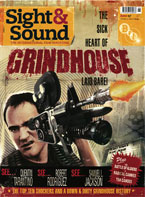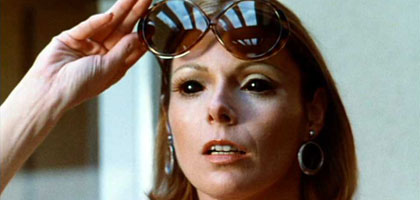
10 Picks from the Grindhouse

He knows far too much about sleaze, gore and pulchritude than is good for him. He is not usually allowed outside the confines of NoZone - but when trash comes to shove, no one does a more authentically scuzzy Top Ten than Tim Lucas
The Abductors (1972)
What is a grindhouse movie? Here's my best definition: it's a movie that makes you want to run, not walk, to the nearest shower, but leaves you unable to decide whether the shower should be hot or cold. Few films better fill the bill than the Ginger series, three super-sleazy, soft-X roughies built around 23-year-old ex-cheerleader Ginger McAllister (played by Cheri Caffaro, writer-director Don Schain's wife), who looks at least 33 and goes undercover in more ways than one to crack various sex-related cases. Financed by a New Jersey Oldsmobile dealership, the unremittingly scuzzy Ginger (1971) was a huge success. The trilogy's second chapter The Abductors, about an organisation that kidnaps young women to provide "mistresses in bondage" for a six-figure-paying business elite, boasts better production values and props (like a helicopter) while repeating the original's formula of grossly manhandled nudes, bondage/rape fantasies and cheap pseudo-Bondian accessories (gas-station road maps handled like top-secret documents; 'radar losenges' for tracking a planted abductee). But Ginger's Olds is no Aston Martin, and when the film indulges its star with yet another lengthy dance sequence (this time with a lamely swung maraca), one wonders how such an uninspiring woman could be the centre of her own world, much less everyone else's.
The Baby (1972)
Grindhouse audiences are seldom sated by blood and nudity alone; they also want to see ageing actors crawling on their stomachs across the broken-glass-strewn floors of scripts they would have snubbed in their heyday. In this sensational oddity, directed by Ted Post following his major studio stint on Magnum Force, Ruth Roman (Strangers on a Train, The Far Country) joins the Baby Jane queue as Mrs Wadsworth, the matriarch of a fatherless suburban family whose daughters (Anjanette Comer and Suzanne Zenor) have been raised to hate men and whose only male offspring (David Manzy) has been allowed to mature in a state of diapered infancy. When Roman's character discovers a babysitter giving her son the physical closeness she's wilfully denied him for 21 years, her performance jumps the tracks into a harrowing display of sadism and psychosis. It's a thought-provoking and polished movie that's hard to imagine playing in mainstream theatres without Tennessee Williams' name on the poster. Also recommended: Gloria Grahame's comeback as a sadistic matron in Blood and Lace (1970).
Coffy (1973)
Like Ginger McAllister from The Abductors, Coffy is a sexually robust woman recruited into crime-fighting to avenge the death of a sibling destroyed by drugs - but that's where any similarity ends. Writer-director Jack Hill (Spider Baby) gets it right; he knows how to make a cheap movie sing and an audience cheer. Pam Grier, in her first starring role, here earned her status as one of the six pillars of grindhouse entertainment. Almost 35 years since its initial release, Coffy retains its ability to startle, amuse, outrage and entertain ("My old man's coming back any minute, and if she catches you here, she's gonna wanna kick your ass!"), and its wild heart is rooted in street wisdom, real societal concerns and constructive, if vengeful thinking. A wacka-wacka rollercoaster ride that delivers everything audiences wanted Shaft to be, and more.
Fight for Your Life (1976)
A young William Sanderson (Blade Runner, Newhart), exuding greasy but undeniable rock-star charisma, toplines as the racist hillbilly ringleader of a group of escaped convicts who intrude on the Thanksgiving dinner of a middle-class black family. With its action mostly limited to two rooms of a suburban house, the belligerent, taunting psychodrama that ensues makes for riveting theatre as well as exploitation, with strong, believable performances all round. The DVD release labels Robert A. Endelson's film as "the least politically correct ever to play in American theaters" - it includes scenes of rape, child murder, and even points a loaded gun at a baby's head - but it's hard to imagine a more persuasive illustration of power as the ultimate enabler of racism, or a more vivid, microcosmic metaphor for the indignities people of colour suffer in America. It's all appallingly impolite on the surface, yet there's an admirable imperative at the root (and in the title): stand up for what you believe in.
Girls at the Gynecologist (Mädchen beim Frauenarzt, 1971)
You'd never see a title like this on a theatre marquee nowadays, but that's not the sole reason for this grindhouse classic's appeal. Ernst Hofbauer, the primary architect behind West Germany's 1970s Schoolgirl Report films, made his most conspicuous grab for auteur status with this real-time story of an afternoon in a gynaecologist's office, starring you as the gynaecologist. In a manner few films other than Robert Montgomery's classic noir Lady in the Lake have attempted, the entire action is observed subjectively through the eyes of its principal character, whose face we never see. Surprisingly, the film also manages to avoid showing us what gynaecologists see daily by the dozens.
I Drink Your Blood (1971)
This seriously unsettling horror film arrived in American theatres cut to shreds to win an MPAA 'R' rating, in a double-bill with an unreleased black-and-white movie from 1964 retitled I Eat Your Skin. The story, which finds the residents of a small town coping with an invasion of rabies-infected hippies, ratchets the already taut social and generational tensions captured by George A. Romero in Night of the Living Dead. Imagining what was excised from the film only intensified its power, and the uncut DVD release confirms the strength of writer-director David E. Durston's vision. Durston's subsequent Stigma (1972) pegged him as a pioneer of the science-based 'venereal horror' field in which David Cronenberg soon overtook him.
Invasion of the Bee Girls (1973)
Scripted by novelist and future director Nicholas Meyer (Time after Time), this was one of the rare films of its time to combine sex, horror, wit and something of a pre-Tarantino trivia sensibility. This randy spoof of 1950s science-fiction movies stars William Smith, a burly actor generally cast as a thug, as a debonair spy named Neil Agar - referencing The Brain from Planet Arous star John Agar. When various male chemical-research lab workers perish of sexual exhaustion, the two-fisted Smith investigates, assisted by former Playboy centrefold Victoria Vetri. For all its sleaze potential, the film is attractively cast and designed, with Anitra Ford especially memorable as the coolly sexy doctor researching bees and royal jelly as counteragents to ageing. In a classic instance of disreputable distribution practices, the movie was put back on the streets in 1977 under the misleading title Graveyard Tramps.
Shanty Tramp (1967)
Produced and distributed by K. Gordon Murray, the bargain-basement Disney who made his fortune importing Mexican fairytale films to the US, this story of the downfall of a small-town tease - a spiritual descendant of Russ Meyer's 1965 Mudhoney - provided a new direction to a once wholesome career. For a 1967 black-and-white film, it's graphically violent and not shy about including in scenes of intense bloodshed the nudity of actress Lee Holland, who plays the hip-swinging lead character Emily. Still stupefying for Emily's knowing corruption of a revival tent preacher and for a climactic scene of incestuous rape and gory patricide, the movie remained in active circulation well into the 1970s, primarily on drive-in triple-bills. Its most shocking aspect was later unearthed by Charles Kilgore in his fanzine Ecco: 'Lee Holland' was actually Eleanor Vaill, a Miami-based substitute schoolteacher. Imagine being a Miami schoolkid sneaking in to see the movie and finding your teacher stark naked and covered in blood on screen. Vaill left the cinema after marrying fellow cast member Otto Schlesinger, who played her rapist father.
Shogun Assassin (1972/80)
From Five Deadly Venoms to Master of the Flying Guillotine and Bruce Lee Fights Back from the Grave, Asian cult cinema has been a hallmark of grindhouse entertainment. Here Robert Houston conflates footage from three different films in Toho's Lone Wolf and Cub series by director Misumi Kenji, about the adventures of a wandering widowed samurai warrior (Wakayama Tomisaburo) and his infant son. Houston's ingenious and deeply imagined reinterpretation also turns out to be a conspicuous example of a beloved grindhouse experience that was in fact rewritten, rescored (by Mark Lindsay of Paul Revere and the Raiders) and disembowelled in the cutting room - and with the arrival of home video the search for the movie's unscreened elements became the obsession of hundreds of fans. It's through this film that the spirit of Yojimbo, as transmogrified by Sergio Leone's Fistful of Dollars, crossed the US on its triumphal return to the land whence it came.
SS Hell Camp aka The Beast in Heat (1977)
A movie so reprehensible that there's not a single real name associated with it (director 'Ivan Kathansky' was actually Paolo Solvay), this Italian-made video nasty doesn't have anything as impressive to offer as the prodigiously endowed torso of Dyanne Thorne in the Ilsa concentration-camp series, so its cup runneth over with mayhem instead. A woman's hand is manacled to a table, covered in blood, as a Nazi torturer uses pliers to pluck one fingernail after another. As the camera pans to the victim's face, she turns our way and says, with all the feeling of someone balancing their chequebook, "Stop... you're hurting me." A fully nude man is dangled upside down and beaten with clubs. Salvatore Baccaro (credited as 'Sal Boris' in a nod to his earlier billing as 'Boris Lugosi' in Frankenstein's Castle of Freaks) plays a subhuman with a scientifically jumpstarted libido who rapes women and gobbles fistfuls of their pubic hair. All this and more is broken up by a subplot about freedom-fighting villagers in which some uncredited but recognisable actors (Brad Harris, Brigitte Skay) turn up in footage originally filmed for an unrelated, orphaned production. The movie was chopped up like hamburger for its bookings in US theatres; watching it uncut on DVD, there's only the intrusive camera shadows, obvious stock-footage inserts and out-of-focus shots to distance us from the experience. When one victim observes, "It's really not such a bad thing to leave this world", we know exactly how he feels... but we can't wait to tell a friend with a similar appreciation of the absurd about what we've just seen.
